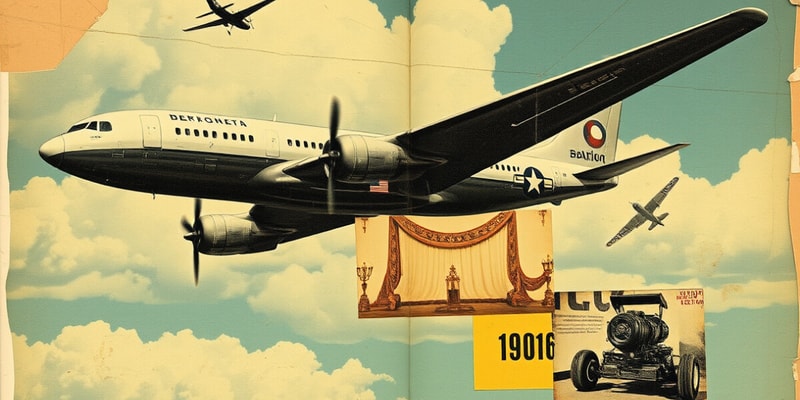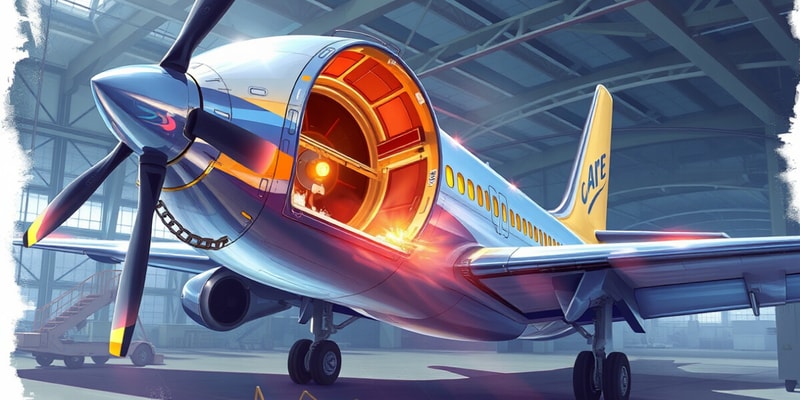Podcast Beta
Questions and Answers
What is the primary cause of wood decay?
What does a grain slope of 1:15 indicate in wood used for aircraft construction?
Which glue is considered the most water-resistant and suitable for both aircraft structure manufacture and field repairs?
What is meant by 'open-assembly time' when gluing wooden aircraft structures?
Signup and view all the answers
What conditions must be met to substitute laminated wood spars for solid rectangular wood spars?
Signup and view all the answers
What are Grade 'A' Cotton and Irish Linen airplane covering materials classified as?
Signup and view all the answers
What is the minimum tensile strength of new undoped Grade 'A' mercerised cotton airplane cloth designed for aircraft with a VNE of greater than 160 MPH?
Signup and view all the answers
What term describes the threads that run the length of the fabric as it comes off the roll?
Signup and view all the answers
Which document is required to approve the replacement of organic fabric covering with synthetic fabric covering on an aircraft?
Signup and view all the answers
What is the minimum tensile strength of pre-waxed cotton fiber rib lacing cord?
Signup and view all the answers
When using 8/4 ply cotton hand sewing thread, what must be done to the thread before it is utilized?
Signup and view all the answers
In a Pratt-type truss wing construction, how are compression loads typically managed between the front and rear spars?
Signup and view all the answers
What is the advantage of a built-up I-beam wooden spar over a solid wooden spar?
Signup and view all the answers
What is the essential difference between plywood and laminated wood?
Signup and view all the answers
How is a compression failure typically identified in a wooden spar?
Signup and view all the answers
What is the role of diagonal members in the Warren truss design?
Signup and view all the answers
Which of the following is required for laminated wood spars to replace solid rectangular wood spars?
Signup and view all the answers
What is the function of reinforcing tape when applying fabric covering to an aircraft wing?
Signup and view all the answers
What determines the suitability of other woods for aircraft construction?
Signup and view all the answers
What is the minimum tensile strength required for new undoped Grade 'A' mercerised cotton airplane cloth for high-speed aircraft?
Signup and view all the answers
What approval document is necessary when replacing organic fabric covering on an aircraft with synthetic material?
Signup and view all the answers
What is the purpose of using wax on 8/4 ply cotton hand sewing thread before use?
Signup and view all the answers
What are the two types of finishing dope that can be applied to aircraft organic fabric coverings?
Signup and view all the answers
In a Pratt-type truss wing construction, how are drag wires positioned?
Signup and view all the answers
What can be used as an alternative guide for maintaining a fabric covering if the Manufacturer’s Service Manual or STC is unavailable?
Signup and view all the answers
What is the classification of covering materials such as Ceconite®, Polyfibre®, and Superflite®?
Signup and view all the answers
Study Notes
Organic and Inorganic Fabric Materials
- Grade “A” Cotton and Irish Linen serve as organic fabric materials for airplane coverings.
- Ceconite®, Polyfibre®, and Superflite® are classified as inorganic fabric materials.
Tensile Strength Requirements
- Minimum tensile strength of new undoped Grade “A” mercerised cotton airplane cloth is 56 lb. per inch width for aircraft with a VNE over 160 MPH and wing loading over 9 pounds per square foot.
- Pre-waxed cotton fibre rib lacing cord requires a minimum tensile strength of 40 lbs.
Fabric Construction Terminology
- The threads running the length of the fabric are referred to as "warp."
- Two types of finishing dope for organic fabric coverings include Cellulose Nitrate Dope and Butyrate Dope.
Fabric Covering Approvals
- An STC (Supplemental Type Certificate) is required for approval when replacing organic fabric covering with synthetic fabric.
- In the absence of a Manufacturer’s Service Manual or STC, FAA AC 43.13-1B/2A may be used as an alternate maintenance guide.
Application Techniques
- Reinforcing tape is typically applied under rib lacing to strengthen the fabric covering against potential damage from attachment devices.
- When using 8/4 ply cotton hand sewing thread, it must be waxed before application.
Fabric Rejuvenation
- Rejuvenator can restore the surface finish of fabric coverings that have become dried out, brittle, or cracked.
Wing and Fuselage Construction
- Compression loads in Pratt-type truss wings are managed with compression struts or ribs to prevent rib crushing.
- Built-up I-beam wooden spars are lighter than solid wooden spars.
- Drag wires in a Pratt-type truss wing run diagonally opposite to main load-carrying members.
- The Warren Truss fuselage structure is defined by longerons and diagonal members that carry both compressive and tensile loads.
Wood Specifications and Regulations
- The essential difference between plywood and laminated wood lies in the direction of grain between layers; plywood is at 90 degrees while laminated wood is parallel.
- Sitka Spruce is the reference wood for evaluating the suitability of other wood types in aircraft construction.
- Substituting laminated wood spars for solid spars is permissible under specific design, performance, approval, testing, and regulatory conditions.
- The term "grain slope of 1:15" indicates that wood grain may rise no more than 1 inch over 15 inches in length.
Adhesives and Wood Maintenance
- Resorcinol Glue is the most water-resistant adhesive suitable for aircraft manufacturing and field repairs.
- "Open-assembly time" refers to the period allowed between glue application and joint assembly.
- Excess moisture is identified as the primary cause of wood decay.
- Compression failure in wooden spars is characterized by fine lines across the grain, indicating ruptured fibers.
Organic and Inorganic Fabric Materials
- Grade “A” Cotton and Irish Linen serve as organic fabric materials for airplane coverings.
- Ceconite®, Polyfibre®, and Superflite® are classified as inorganic fabric materials.
Tensile Strength Requirements
- Minimum tensile strength of new undoped Grade “A” mercerised cotton airplane cloth is 56 lb. per inch width for aircraft with a VNE over 160 MPH and wing loading over 9 pounds per square foot.
- Pre-waxed cotton fibre rib lacing cord requires a minimum tensile strength of 40 lbs.
Fabric Construction Terminology
- The threads running the length of the fabric are referred to as "warp."
- Two types of finishing dope for organic fabric coverings include Cellulose Nitrate Dope and Butyrate Dope.
Fabric Covering Approvals
- An STC (Supplemental Type Certificate) is required for approval when replacing organic fabric covering with synthetic fabric.
- In the absence of a Manufacturer’s Service Manual or STC, FAA AC 43.13-1B/2A may be used as an alternate maintenance guide.
Application Techniques
- Reinforcing tape is typically applied under rib lacing to strengthen the fabric covering against potential damage from attachment devices.
- When using 8/4 ply cotton hand sewing thread, it must be waxed before application.
Fabric Rejuvenation
- Rejuvenator can restore the surface finish of fabric coverings that have become dried out, brittle, or cracked.
Wing and Fuselage Construction
- Compression loads in Pratt-type truss wings are managed with compression struts or ribs to prevent rib crushing.
- Built-up I-beam wooden spars are lighter than solid wooden spars.
- Drag wires in a Pratt-type truss wing run diagonally opposite to main load-carrying members.
- The Warren Truss fuselage structure is defined by longerons and diagonal members that carry both compressive and tensile loads.
Wood Specifications and Regulations
- The essential difference between plywood and laminated wood lies in the direction of grain between layers; plywood is at 90 degrees while laminated wood is parallel.
- Sitka Spruce is the reference wood for evaluating the suitability of other wood types in aircraft construction.
- Substituting laminated wood spars for solid spars is permissible under specific design, performance, approval, testing, and regulatory conditions.
- The term "grain slope of 1:15" indicates that wood grain may rise no more than 1 inch over 15 inches in length.
Adhesives and Wood Maintenance
- Resorcinol Glue is the most water-resistant adhesive suitable for aircraft manufacturing and field repairs.
- "Open-assembly time" refers to the period allowed between glue application and joint assembly.
- Excess moisture is identified as the primary cause of wood decay.
- Compression failure in wooden spars is characterized by fine lines across the grain, indicating ruptured fibers.
Studying That Suits You
Use AI to generate personalized quizzes and flashcards to suit your learning preferences.
Description
Test your knowledge on Grade 'A' cotton and Irish linen used in aircraft coverings. This quiz covers tensile strength requirements and specific terminologies related to aviation fabric materials. Perfect for aviation students and professionals.





